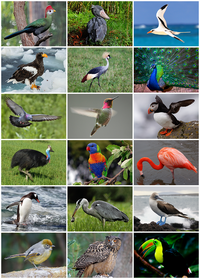
Cooperative breeding shapes post‐fledging survival in an Afrotropical forest bird
Sign Up to like & getrecommendations! Published in 2017 at "Ecology and Evolution"
DOI: 10.1002/ece3.2744
Abstract: Abstract For avian group living to be evolutionary stable, multiple fitness benefits are expected. Yet, the difficulty of tracking fledglings, and thus estimating their survival rates, limits our knowledge on how such benefits may manifest… read more here.
Keywords: breeding shapes; post fledging; breeding; condition ... See more keywords

A case of cooperative breeding in the European Starling, Sturnus vulgaris
Sign Up to like & getrecommendations! Published in 2022 at "Ecology and Evolution"
DOI: 10.1002/ece3.8318
Abstract: Abstract Cooperative breeding, where individuals other than the parents help to raise offspring, occurs in only ~9% of bird species. Although many starlings (Sturnidae) are cooperative breeders, the European starling (Sturnus vulgaris) has rarely been… read more here.
Keywords: sturnus vulgaris; breeding; cooperative breeding; starling sturnus ... See more keywords

Meerkats (Suricata suricatta) fail to prosocially donate food in an experimental set-up
Sign Up to like & getrecommendations! Published in 2017 at "Animal Cognition"
DOI: 10.1007/s10071-017-1122-6
Abstract: Although humans are usually believed to be prosocial, the evolutionary origins of prosociality are largely debated. One hypothesis is that cooperative breeding has been one major precursor to the emergence of prosociality. In vertebrates, however,… read more here.
Keywords: food; cooperative breeding; prosociality; suricata suricatta ... See more keywords

Climate and the distribution of cooperative breeding in mammals
Sign Up to like & getrecommendations! Published in 2017 at "Royal Society Open Science"
DOI: 10.1098/rsos.160897
Abstract: Cooperative breeding systems, in which non-breeding individuals provide care for the offspring of dominant group members, occur in less than 1% of mammals and are associated with social monogamy and the production of multiple offspring… read more here.
Keywords: breeding; breeding mammals; cooperative breeding; climate distribution ... See more keywords

Cooperative breeding and the emergence of multilevel societies in birds.
Sign Up to like & getrecommendations! Published in 2022 at "Ecology letters"
DOI: 10.1111/ele.13950
Abstract: Multilevel societies (MLSs), where social levels are hierarchically nested within each other, are considered one of the most complex forms of animal societies. Although thought to mainly occurs in mammals, it is suggested that MLSs… read more here.
Keywords: breeding emergence; multilevel; cooperative breeding; cooperatively breeding ... See more keywords

The evolution of cooperative breeding by direct and indirect fitness effects
Sign Up to like & getrecommendations! Published in 2022 at "Science Advances"
DOI: 10.1126/sciadv.abl7853
Abstract: The evolution of cooperative breeding has been traditionally attributed to the effect of kin selection. While there is increasing empirical evidence that direct fitness benefits are relevant, the relative importance of alternative selection mechanisms is… read more here.
Keywords: breeding direct; cooperative breeding; alloparental care; fitness ... See more keywords

Family living sets the stage for cooperative breeding and ecological resilience in birds
Sign Up to like & getrecommendations! Published in 2017 at "PLoS Biology"
DOI: 10.1371/journal.pbio.2000483
Abstract: Cooperative breeding is an extreme form of cooperation that evolved in a range of lineages, including arthropods, fish, birds, and mammals. Although cooperative breeding in birds is widespread and well-studied, the conditions that favored its… read more here.
Keywords: cooperative breeding; evolution cooperative; family living; breeding ... See more keywords

Experimental evidence that group size generates divergent benefits of cooperative breeding for male and female ostriches
Sign Up to like & getrecommendations! Published in 2022 at "eLife"
DOI: 10.7554/elife.77170
Abstract: Cooperative breeding allows the costs of parental care to be shared, but as groups become larger, such benefits often decline as competition increases and group cohesion breaks down. The counteracting forces of cooperation and competition… read more here.
Keywords: cooperative breeding; group size; group; male female ... See more keywords